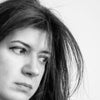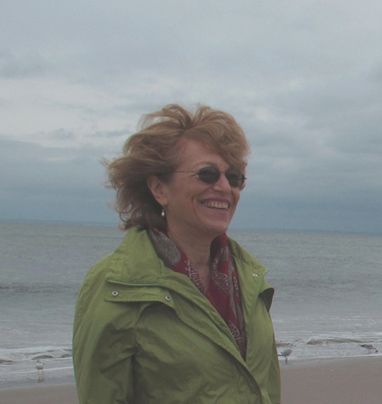Jan Castro. Photo: Christina Whiting
Jan Castro is an art historian and an accomplished author and critic. Her books include The Art & Life of Georgia O'Keeffe, which sold over 100,000 copies. She is also a contributing editor for Sculpture Magazine (seventeen cover stories, many essays & interviews). This past spring, Jan mentioned to me she was curating an upcoming exhibition, so I thought it would be interesting to have her share her thoughts on writing and curating.
Lilia Ziamou: How does curating compare to writing about art?
Jan Castro: Curating and writing both involve working closely with each artist and with all people related to the artist and the exhibition or assignment. Curating may involve many works by one artist or fewer works by many artists. So each exhibition depends on the artist(s) and number of works involved. As a writer, whether I am writing interviews, catalog essays, reviews, or essays, my work usually does not involve the material concerns of an exhibition. Each artist and each genre of writing call for different kinds of attention. My book on Georgia O'Keeffe, for example, took ten years to research, write and publish.
Lilia Ziamou: Do you look at art differently when you curate vs. when you write?
Jan Castro: No. But this is a really good question. Curating an exhibition and writing about art both require more than seeing the work, including research related to the artist's career, critical reception, and historical and other contexts related to the work's creation. In both cases, you try to learn as much as you can about the art. Art should be accessible without talking to the artist, but there is often more to see after talking to her/him - if the artist is alive. For example, Louise Bourgeois often had witty, curious things to say about her work and processes, and her prolific writings are more accessible than most. So "seeing" art often involves the senses, mind, and body.
Lilia Ziamou: You have recently co-curated, with Eileen Jeng, New Ways of Seeing: Beyond Culture currently on view at Dorsky Gallery Curatorial Programs. How did the idea for the exhibition come about?
Jan Castro: America has strong divisions; problems arise related to race, class, politics, and culture. Our idea was to select international artists whose work may be related to the artist's original culture yet is also inclusive of other cultures and ideas. New Ways of Seeing is relevant to all cultures. My co-curator Eileen Jeng and I applied to the Dorsky Curatorial Programs. They accepted the idea fairly quickly. Then it took about thirteen months to realize the project, install the art, and write the essay.
Lilia Ziamou: What do you hope to achieve with this exhibition?
Jan Castro: I write for Sculpture Magazine, and I love to interview artists whose countries of origin are diverse. So, it is something I have been practicing as a writer. The twenty artists in the exhibition have countries of origin that include the United States, Korea, China, Peru, Chile, Mexico, Jamaica, India, and Africa. We wanted diversity. Today's artists are reaching out beyond their countries of origin. They are inclusive of others even if they themselves have been discriminated against at some stage of their lives. The whole idea is to find common ground. When you visit the exhibition, you see many different kinds of imagery, yet the works speak to each other. The exhibition is not about artists from different countries and cultures representing their culture to the world, but the opposite; it is about throwing out false pre-judgments that we all face in varying degrees.
Lilia Ziamou: How important are materials in expressing cultural contexts?
Jan Castro: In New Ways of Seeing, you notice that all the work is beautifully crafted; you don't immediately pay attention to the range of different materials, but you notice that the aesthetic is strong and the works seem to be talking to each other. You don't need to know about the specific materials to appreciate the work or to think about what the art is trying to say.
Lilia Ziamou: In your essay that accompanies the exhibition, you quote John Berger's Ways of Seeing: "The way we see things is affected by what we know or what we believe." How do you as a curator of the exhibition help the viewer transcend prior beliefs?
Jan Castro: Even though most viewers have never seen work like this before, most are quite impressed. You have the opportunity to examine it more closely than if you walked by it and were repulsed or annoyed by it. Once its aesthetic component draws you in, you may be open to having a conversation with it and come away with an appreciation about something different than what you're used to seeing in exhibitions.
Lilia Ziamou: A few words on the upcoming programs.
Jan Castro: We have programs on June 7 and June 21. On June 7, Michelle Yun, Senior Curator of Modern and Contemporary Art at Asia Society Museum moderates a discussion about cultural identity and aesthetic conventions with three artists. On June 21, my co-curator and I, along with three artists, will discuss the art with the public as we walk through the exhibition. Both programs are free and open to the public. It's important to note that most of our artists - Claudia Alvarez, Afruz Amighi, Rina Banerjee, Christian Ruiz Berman, Sanford Biggers, Cui Fei, Leonardo Drew, Rashawn Griffin, Rachel Eliza Griffiths, Wenda Gu, Ginny Huo, Tamiko Kawata, Ivan Navarro & Courtney Smith, Kambui Olujimi, Cecilia Paredes, Soo Sunny Park, Yinka Shonibaare, MBE, Nari Ward, and Ishmael Randall Weeks -- have had important solo exhibitions and all were most generous in lending us their work.
Lilia Ziamou: Any concluding thoughts?
Jan Castro: I moved to New York about twelve years ago because I had hit my glass ceiling in St. Louis. New York has opened many doors for me, and I fully appreciate the wealth of ideas here and the number of brilliant and talented individuals.
New Ways of Seeing: Beyond Culture, curated by Jan Garden Castro and Eileen Jeng will be on view at Dorsky Gallery Curatorial Programs, 11-03 45th av., Long Island City, NY, until July 12, 2015.
See Jan Castro's selected essays on artists:Essays and her Blog:Jan Castro's Blog.

